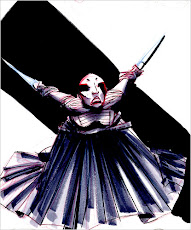Thursday, June 26, 2008
Bladerunner
-- What does Deckard "realize" when he looks at the origami on the floor outside his apartment, just as he is leaving with Racheal?
-- Why does Gaff give Deckard a gun when he says "Its too bad she won't live, but then again, who does?"
-- What does this phrase, stated and repeated in both these scenes have to do with the overall 'message' of the film?
Then, please read the Doppleganger handout, and include in your comments how you understand the 'double' relationship between Deckard and Roy and what you think the implicit comparison between Racheal and Pris in the movie is about.
--Do you think Pris and Racheal are "dopplegangers" in the same way that Deckard and Roy seem to be?
--Are Deckard and Roy "doubles" in some sense (mentioned in the handouts) ? Here's a hint: think about when your 'sympathy' for Deckard, begins to switch to Roy... how did that work, eh? But you know what I mean right? At some point, we are confused about who we feel sorry for, at least most viewers are... I think. But did our sympathies switch from Racheal to Pris? Just curious... your views?
-- How would you describe the characters of Pris and Racheal as "future females", how would you compare them to the Bride and Maria so far?
I hope you enjoyed the movie, I know it is one of my top ten of all time.
Monday, June 23, 2008
your 2nd Matrix Post
I have sent all of you this very informative article that compares Gnosticism and Buddhism in The Matrix. You can use it to understand the ways that The Matrix deviates from or re-writes orthodox christian allegory. It is also useful to see parallels between gnostic and eastern religious traditions. If you know anything about Shinto, and would like to use your post to tell us if Shinto has similar concepts (I am not sure that it does) please do!
From the wikipedia entry on Shinto:
'Because Shinto has co-existed with Buddhism for well over a millennium, it is very difficult to untangle Shinto and Buddhist beliefs about the world. Though Buddhism and Shinto have very different perspectives on the world, most Japanese do not see any challenge in reconciling these two very different religions, and practice both. Thus it is common for people to practice Shinto in life yet have a Buddhist funeral. Their different perspectives on the afterlife are seen as complementing each other, and frequently the ritual practice of one will have an origin in the other.'
Kami
'Shinto teaches that everything contains a kami ("spiritual essence" which is sometimes translated into "god", though perhaps soul or spirit would be more accurate; an even better translation would actually be "The Sacred"). Every rock, every squirrel, every living and nonliving thing contains a kami. There is also a main kami for groups of things: for example, there is a kami within a rhino, and there is also a main kami residing over all the rhinos of the world.'
'The most immediately striking theme in the Shinto religion is a great love and reverence for Nature in all its forms and for natural artifacts and processes. Thus, a waterfall, the moon, or just an oddly shaped rock might come to be regarded as a kami; so might charismatic persons or more abstract entities like growth and fertility. As time went by, the original nature-worshipping roots of the religion, while never lost entirely, became attenuated and the kami took on more reified and anthropomorphic forms, with a formidable body of myth attached to them. (See also: Japanese mythology.) The kami, however, are not transcendent deities in the usual Western and Indian sense of the word. Although divine, they are close to humanity; they inhabit the same world as we do, make the same mistakes as we do, and feel and think the same way as we do. Those who died will usually become kami, with their power and main characteristics given by their doings in life. Those believing other religions may be also venerated as kami after death, if there are Shinto believers who wish them to be.'
'Shinto can be seen as a form of animism and may be regarded as a variant of shamanist religion. Shinto beliefs and ways of thinking are deep in the subconscious fabric of modern Japanese society. The afterlife is not a primary concern in Shinto; much more emphasis is placed on fitting into this world, instead of preparing for the next.'
- June 22, 2008 3:39 PM



